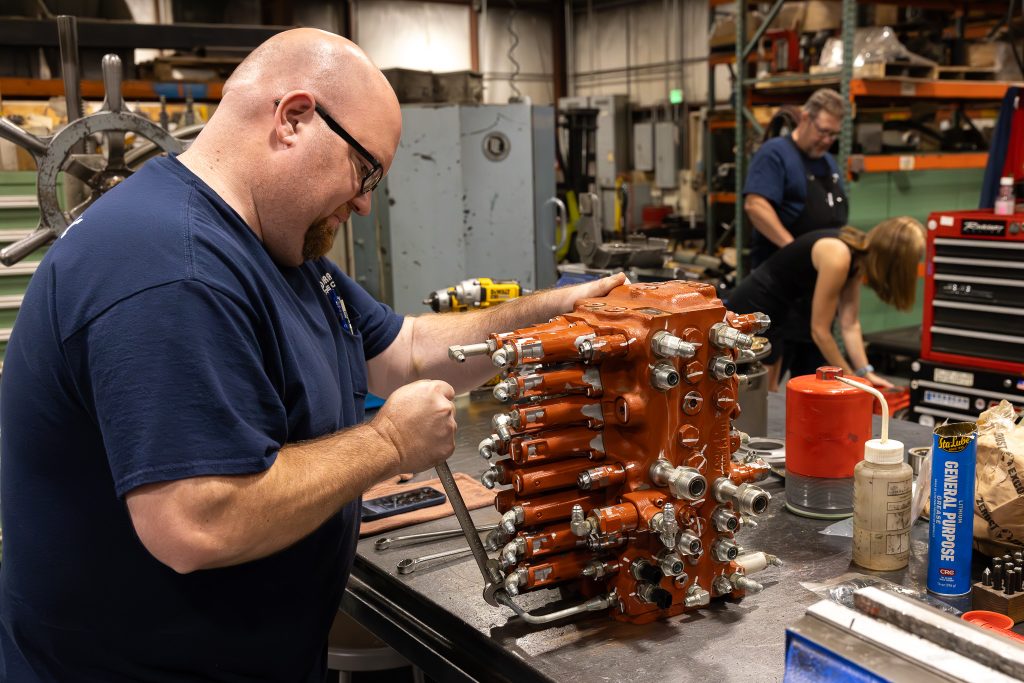At Allied Hydraulic Service Co, we specialize in the repair, rebuilding, and replacement of hydraulic motors, pumps, and valves. With years of expertise and a commitment to KICK@$$ for our customers, we ensure hydraulic systems operate efficiently and reliably.

Understanding the common causes of hydraulic component failure helps in preventive maintenance and timely repairs. Here are some typical issues:
Motors (Radial Piston Motors, Geroter Motors, Piston Motors, and Vane Motors):
Pumps (Axial Pumps, Radial Piston Pumps, Closed Loop Hydrostatic Pumps, Open Loop Pumps, Gear Pumps, Vane Pumps, Load Sensing Pumps, Horsepower Limiting Pumps, Fixed Variable Displacement, and Fixed Displacement):
Valves (Sectional, Monoblock, Load Sensing, Standard FDA, and Excavator Valves):
Don’t see your product below? Reach out, we may be able to help!
We start with a thorough inspection to identify the root cause of the failure. This includes checking for fluid contamination, seal integrity, and any signs of wear or damage.
The hydraulic component is carefully disassembled to access and inspect internal parts. This step is critical to ensure all potential issues are identified and addressed.
If fluid contamination is detected, we thoroughly clean and flush the hydraulic system to remove any debris and contaminants. We then replace the hydraulic fluid with clean, recommended oil.
Any worn or damaged parts, such as seals, gaskets, or bearings, are replaced with high-quality components to restore the system’s integrity and performance.
For valves repairs, worn bodies are precision honed for cleanup and straightness. Pitted and worn spools are pre-ground, chrome plated, finish ground and are refitted back into the valve body to proper tolerance.
The component is reassembled and dynamically pressure tested on our state-of-the-art test stand to test for proper GPM, PSI, external leakage, and torque output.
All check vales, cylinder ports relief, and the main relief are inspected, reseated, and reset to manufacturer’s specifications. Internal leakage is measured in cubic inch leakage per minute and back pressured for external leakage.
After successful testing, we perform final check and the units are fitted with cap plugs and painted.
Signs of a failing hydraulic pump include unusual noises (such as banging or whining), reduced efficiency, overheating, and visible fluid leaks. Regular maintenance checks can help identify these issues early
Regularly check and replace hydraulic fluid and filters, inspect seals and connections for leaks, ensure proper fluid levels, and monitor system temperature. Following the manufacturer’s maintenance schedule is also critical.
Overheating can be addressed by checking for proper fluid levels, ensuring the correct type of hydraulic fluid is used, and inspecting the system for any blockages or leaks. Cooling measures may also be necessary.
The frequency of hydraulic fluid replacement depends on the type of system and the operating conditions. As a general guideline, it’s recommended to change the hydraulic fluid every 1,000 to 2,000 operating hours or at least once a year. We recommend following the manufacturer’s maintenance schedule and regularly inspect the fluid for contamination and degradation.
While some basic maintenance tasks, like checking fluid levels and replacing filters, can be performed by operators, repairing hydraulic motors, pumps, and valves usually requires specialized knowledge and tools. Incorrect repairs can lead to further damage and safety hazards. Therefore, it’s advisable to seek professional help from experts like us to ensure proper diagnosis and repair.